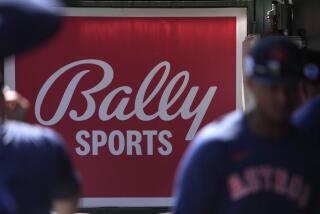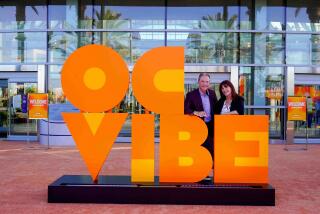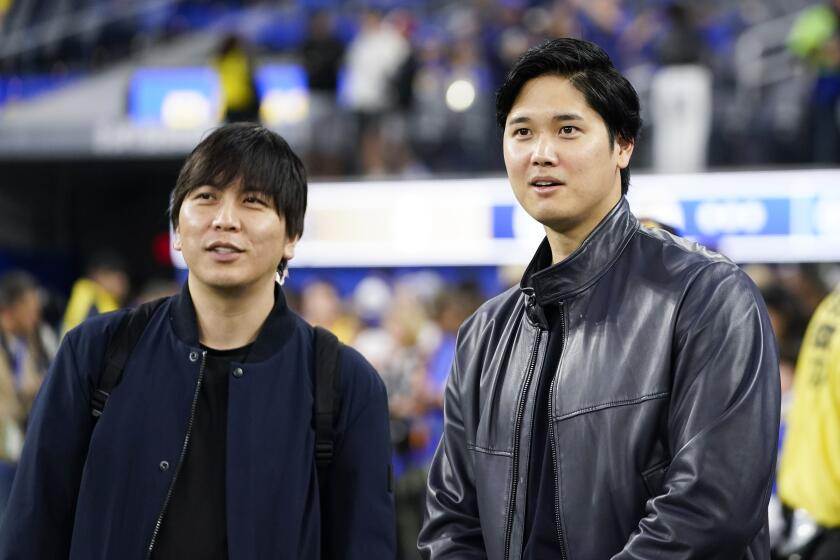THE ANGELS VS. ANAHEIM : Costly Parking-Lot Dispute, With Its Bad-Faith Overtones, Sours a Once-Amicable Relationship
At the annual Chamber of Commerce luncheon held last April to kick off the Angels’ 1985 season, Anaheim Mayor Don Roth was surprised to find there was no seat for him at the head table. Then, for the first time in 10 years, Angels owner Gene Autry refused to accept the framed proclamation the mayor traditionally reads, wishing the team well in the coming season.
The Angels said the proclamation was hypocritical, considering that the club and the city have been embroiled in a bitter two-year-long legal dispute.
“I can’t understand how the City Council can approve stuff like (the proclamation),” Autry said after the luncheon.
The city, meanwhile, called the incident a “snub.” Though upset, Roth insisted that he was not embittered by the incident. “I’m a mayor of a big city,” he said after the event. “I have to be above all this. If I were bitter, I’d go home and kick the cat. . . .”
String of Barbs Back and Forth
The words exchanged during the luncheon incident were an example of a string of barbs that officials from both the city and the Angels have tossed at each other since the baseball club filed a $100-million lawsuit against Anaheim on Aug. 8, 1983--19 years to the day since the team signed a contract to make the city its home.
The lawsuit, which is scheduled for a trial Monday unless the parties reach a settlement this weekend, was filed to halt development of the stadium parking lot.
The Angels contend that the fracas is about parking space. The city says it’s about hurt feelings and sharing the profits of development. Either way, at the heart of the dispute are the promises the city made to get first the California Angels, then the Los Angeles Rams, to move to Anaheim.
The legal battle has been expensive for both sides. The Angels so far have spent more than $1.5 million in legal costs and contend that their bill is far smaller than the city’s.
The city, meanwhile, has refused to disclose how much it has spent overall. It has said only that it spent $307,694 in legal fees for one of its five suits with the Angels.
If the Angels lose this $100-million suit, they will be relegated to playing ball in a stadium that will eventually have high-rise towers and parking garages in part of its parking lot.
“Mr. Autry has said there is no way the Angels could play baseball there with all that development on . . . the parking lot,” said Michael Schreter, vice president of Goldenwest Baseball Co., the Angels’ parent organization.
“That’s not being realistic,” said William O. Talley, Anaheim city manager. “That’s saying, ‘This is the world as we want it.’ ”
‘Can’t Take a No’
Talley said Autry was not invited as a third party in the plan with Anaheim Stadium Associates but had more than a decade to come to the city with his own proposals. Now, the former “singing cowboy,” once part-owner of the Rams, “can’t take a no,” the city manager said.
“I don’t think they’ve ever been told no,” Talley said. “He’s a wealthy individual, and the wealthy get used to a certain way of life.”
Angels officials have insisted that the lawsuits were spurred by concern over parking and not anger at being left out of the multimillion-dollar development deal.
Lawsuit by Associates
Meanwhile, if the city loses the parking-lot lawsuit, it will set in motion yet another lawsuit, this one filed by Anaheim Stadium Associates--a partnership of the Boston-based development firm of Cabot, Cabot and Forbes and Ramco, a trust for the heirs of the late Rams owner Carroll Rosenbloom.
The partnership, which has a contract to build on the area, filed its $2.5-million action in Orange County Superior Court last January. According to the suit, the Rams came to Anaheim only because the city promised the partnership a development package for the parking lot--land that it allegedly had no rights over. Anaheim Stadium Associates has asked the court to force Anaheim to compensate the partnership for any loss or damage caused by the Angels’ litigation.
And, Talley says, if the city loses, it has the option to use the power of eminent domain to condemn the stadium parking lot for other use.
“If they win, which I doubt, they’re forcing us to condemn (the parking lot),” Talley said. “I’m not saying we’re going to, but we can if we lose.”
‘Holds Some Hope’
Still, James Kenyon, president of Cabot, Cabot & Forbes, said that although he is not optimistic, he holds some hope “that we can settle this. . . . We’re all big boys, and I think we can sit down and settle this and get on with our lives.”
For Anaheim Stadium Associates, “getting on with our lives” means developing the proposed Stadium Center--a $200-million complex of four office towers and four multilevel parking structures on 20 acres that has been described in brochures as having a sense of “urban recognizable identity, similar to Century City and Rockefeller Center.”
Though no construction had begun before the suit was filed, the city had approved plans for the first of the four towers. Development plans also include a second phase to include unspecified construction on 48 acres on additional parking lot space.
Although some local officials refuse to comment on the dispute, others express concern that the fight might spill beyond Anaheim’s borders.
“Both those franchises (Angels and Rams) are valuable to the county, not just to the City of Anaheim,” Costa Mesa City Manager Allan Roeder said. “Those who go to games stay at hotels around the county, go to different restaurants. It’s not just strictly localized. There are economic spinoffs. And there is the recognition and publicity that both of those bring to Orange County.”
Exclusive Use Claimed
The Angels contend that a 1964 contract with the city promised the team the exclusive use of 146 acres. However, the Rams were guaranteed in a 1978 lease with the city that they could build the Stadium Center project on that very same lot as an incentive to leave Los Angeles Memorial Coliseum for the Big A.
To Bill Robertson, president of the Coliseum Commission when the Rams decided to leave, the football team’s deal was a coup. “I’ve come to the conclusion there is nothing we could have given Rosenbloom that would have compared with what Anaheim is giving him,” Robertson said at the time. “. . . . The Rams have pulled off the fattest kill in the history of sports.”
But to Autry, the Rams deal was tantamount to Anaheim selling one piece of real estate to two bidders. “You Can’t Sell the Same Horse Twice” is the title of a pamphlet he has printed and distributed to community organizations.
Meanwhile, Rams attorney Jay Zygmunt refused to comment on the football club’s lease or any part of its relationship with Anaheim because of pending litigation involving the city, the Rams and the Angels. “It has nothing to do with (how we feel about) the City of Anaheim or with the Angels, but the Rams’ position is that we do not comment on any of our litigation in any fashion,” Zygmunt said.
Two Provisions Disputed
The dispute between the Angels and Anaheim boils down to two provisions of the original ground lease between the city and the baseball club, which was finalized on Aug. 8, 1964. In the document, Anaheim promised to build a new, multipurpose stadium on a 146-acre parcel with seating capacity for about 45,000 and a minimum of 12,000 parking spaces.
The city promised that “no reduction or diminution in any of the facilities, equipment or improvements furnished by (Anaheim) . . . shall be made during the continuance of this lease agreement without the advance written consent” of the Angels.
Schreter contends that the sentence is a guarantee that the stadium parking facilities would not be changed without the team’s consent. He says the team never was asked for and never has given such a consent to parking-lot development.
“Every testimony that’s been taken by witnesses around when the 1964 lease agreement was struck recognized that the Angels leased 146 acres of cornfield,” Schreter said. “We were promised the stadium and a minimum amount of parking of 12,000 spaces. But everyone knew we would probably have more. We leased 146 acres, not 12,000 spaces.”
Apparent Contradiction
But the other key provision appears to contradict the first:
“It is understood and agreed that the 146 acres . . . shall be under the exclusive control of lessor (Anaheim) and is not in any way bound to use for lessee (the Angels).”
The city bases much of its legal argument on that clause and takes the passage at face value.
However, Angels officials contend that the sentence was included in the contract in an attempt to avoid paying the county a special fee called a possessory interest tax. Cities and other public bodies are immune from standard real estate taxes on public land unless they lease the property to a private third party, such as the Angels. If they do lease the land in that fashion, a possessory interest tax is levied against the private party.
The Angels and the city agreed in 1964 that the city would pay the tax if it was levied. But both sides hoped that the provision would exempt the team from paying the tax because the Angels would not constitute a private third party with exclusive control.
Schreter says the sentence was placed in the 1964 contract so that, if the county tried to levy a possessory interest tax, the team and the city could argue that the team had no financial interest in the parking lot, that it was the city’s.
Tax Levied by County
The county levied the tax in the late 1960s. The Angels and the city took the county to court and lost. In 1972, an Orange County Superior Court judge ruled that the lease specifically said the Angels had exclusive use of the 146 acres for game days, Schreter said.
“The argument failed,” he said. “So what the hell are we spending hundreds of thousands of dollars arguing this when it was decided in 1972 that the Angels have exclusive use of this land?”
Talley says the city grossed about $3.2 million from the Angels a year in 1981, 1982 and 1983, and about $2.6 million annually from the Rams during the same period. The figure includes revenues from concessions, rent and parking.
Bill Turner, stadium operations manager, says the city made only a $157,000 profit during the 1983-84 fiscal year--from the Angels, the Rams and all other tenants combined.
The proposed development deal with Anaheim Stadium Associates would mean jobs, money and a “commercial anchor,” as officials look to the stadium area for additional office developments. The project is expected to generate 250 jobs a year in the construction trades during the next 10 years.
Once completed, the Anaheim Stadium Center would employ about 8,000 people, Anaheim officials said. The completed project would bring into city coffers about $1.7 million a year in taxes, land- lease and ground-fee assessments--more than $500,000 a year once annual service costs are deducted.
But construction was put on hold when Angels officials protested that the development would take away parking spaces from the fans, who, the Angels said, would think twice about coming to a game if they had to contend with the traffic congestion often experienced in multilevel parking structures.
The development slated for 20 acres on Orangewood Avenue would take away 2,868 spaces from their current 16,000 spaces, Angels attorney Don Morrow said. In addition, development eventually slated for the area of State College Boulevard will take away 5,422 spaces, he said.
However, Talley said the number of parking spaces will increase, not decrease, with the construction of four, multilevel parking garages, providing up to 2,695 additional spaces.
8,700 Spaces Used
Besides, Talley said, the Angels’ fans use only about 8,700 parking spaces per game. Only 18 times in the past three years did fans use more than 12,000 parking spaces, he said.
Team officials, however, say they are shooting for greater attendance with a more aggressive marketing campaign that will crowd the lots to a greater extent. But regardless of the parking spaces currently used, the Angels argue that the city violated its lease with the Angels in agreeing to the plans that would take away flat parking.
“It is a common opinion across the nation, shared by our fans, the Angels and the City of Anaheim, that we have at Anaheim Stadium the best baseball facility in the major leagues. Parking convenience is a major factor in our No. 1 position. I don’t intend to lose that advantage! And I especially don’t intend to roll over when our lease is being violated by our landlord,” Autry wrote in his pamphlet.
Even if the Angels agreed to the development, there would be no assurance that fans would be able to use the new lots during games, Schreter said.
High-Rise Opposed
And such a promise still would not win the Angels over to high-rise parking garages, Schreter said, because the structures would take too long for thousands of fans to enter and exit.
“It’s an impossibility to comprehend the logic of utilizing high-rise parking garages when they are a disaster in any form of mass exiting,” Schreter said.
While Anaheim officials say they expect the parking-lot lawsuit--and four other suits dealing with issues such as television revenues--to be settled out of court, Angels officials say the case will run its course in court and will be decided by a jury.
All documents in the case have been sealed by the court. But in presentations before community groups, attorneys for the baseball club have cited excerpts from court depositions and city memos submitted in the case. One deposition included an allegedly confidential memorandum circulated among city officials stating that the Rams’ “parking proposal appears to violate Angels’ Lease.”
Rams Conflict Seen
Angels attorneys also point to a review by a city-appointed task force that states that “provisions (of the planned parking lot development) are in conflict with the city’s parking agreement with the Angels and the Rams.”
In one deposition released by Angels attorneys, Anaheim Stadium Inc. President Leonard Smith referred to the 1964 agreement and said that city officials, including Talley, Mayor pro tem Lew Overholt and former Mayor John Seymour, “had best read the lease between the city and the Angels.”
Smith, in a recent telephone interview, said: “I’m sure the lease says that no alterations can be made without the consent of the Angels.”
In another deposition, former Mayor Jack Dutton is quoted as saying there could be “no changes in the total facility without the prior written consent of the Angels.” Both Smith and Dutton are members of the Angels’ Advisory Board, a group of 12 prominent Orange County residents who advise the Angels on different matters.
Overholt, who also has gone before community groups giving the city’s side in the dispute, said recently that the Angels jumped the gun in using statements taken from depositions and confidential city memos for their presentations. The material may not be admissible in court, Overholt said.
When asked about Smith’s and Dutton’s assessments of the 1964 agreement, Overholt said: “That may be their recollection, but that’s not necessarily true. . . . That’s something for a court or a jury to decide.”
One of the most noticeable effects of the Angels’ lawsuit against Anaheim has been to block construction of the Stadium Center, a multimillion-dollar development. Once completed, the first phase of the center will include four office towers--a total of more than 2 million square feet of office space--and four parking structures on 20 acres. An Anaheim spokesman estimated that each parking structure proposed for the Orangewood Avenue block would hold about 900 cars. The city has approved only one of the eight buildings--the 18-story, partly tiered office tower of 400,000 square feet pictured in dark blue in the lower right hand corner of the complex. In brochures, the developer, Cabot, Cabot & Forbes, has described the complex as having a sense of “urban recognizable identity, similar to Century City and Rockefeller Center.”
More to Read
Go beyond the scoreboard
Get the latest on L.A.'s teams in the daily Sports Report newsletter.
You may occasionally receive promotional content from the Los Angeles Times.







